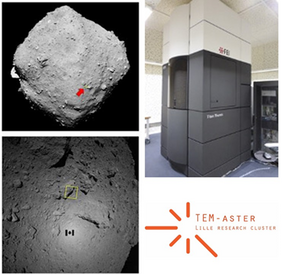TEM-Aster, exploring asteroid rock samples in the lab and the development of new detectors for the STEM
ActualitésAt the end of 2020, the Hayabusa2 mission will bring back to earth, for the first time, samples from a carbonaceous asteroid (called Ryugu). This asteroid should have preserved a mixture of materials dating back from the time of solar system formation, 4.5 billion years ago. The study of these samples will allow us to better understand the ingredients and the processes at the origin of asteroids, comets and planets. The Terrestrial and Planetary Material team at UMET is part of the international consortium which will analyze the samples and was funded by the university through the ISITE structure to support the upcoming investigation.
The goal is to develop the use of direct electron detectors for transmission electron microscopy in order to be able to investigate beam sensitive materials, such as organic matter or hydrated silicates. These new detectors will allow determining the chemical, spectral and structural properties of the materials at the nanometer scale. New acquisition methods based on big data processing will also be developed. The tools elaborated during this project should also be of use for other university groups studying beam sensitive materials, such as polymers, cement, biological and catalytic materials…


